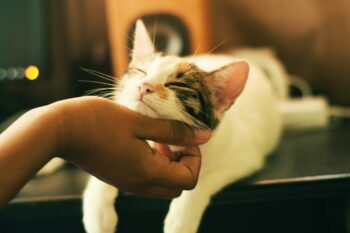Cat food manufacturers spend millions trying to figure out what cats like to eat. But it turns out that a cat’s sense of taste is not all that complex.
The rough, prickly feline tongue is a tool cats have used for centuries. Kitty’s tongue is covered with tiny hook-like barbs called papillae. These barbs are placed on the tongue pointing backwards, and cats use their tongues to remove feathers or fur from their prey and to lick meat from the bones. They also use them to groom. A cat’s tongue mimics a spoon when drinking — enabling her to lap up liquids in quantity, swallowing after every third or fourth lap.
As far as taste buds are concerned, special mushroom-shaped papillae are present at the tip and sides of the tongue. A set of cup-shaped papillae are located at the back of the tongue. According to today’s experts, cats can distinguish between four different tastes: sour, salty, bitter and sweet. Previously, we believed felines were unable to taste sweets because cats rarely show interest in sugary foods. But it’s recently been established that cats have a few sweet-sensitive taste buds on the back of their tongues.
Perhaps cats have been dubbed “finicky” because of their relatively few taste buds in comparison to other species. While felines only have 473 taste buds, their canine counterparts’ tongues contain over 1,700, and there are an astonishing 9,000 taste buds on the human tongue. (Finally, a sense in which we have the advantage over cats!)
 Kitty’s sense of smell and taste are very closely linked. Both senses are registered in the same area of the feline brain. Cats have an “extra” sense (which humans lack), called the Jacobson’s organ. Located in the roof of the mouth, it’s connected to the nasal passage as well — suggesting kitty “smell-tastes” at the same time. When an interesting aroma fills the air, a cat will slightly open her mouth with a curled lip (this look is known as the flehmen response), and inhale the smell on her tongue. Then she rubs her tongue over the roof of her mouth — thus passing the smell/taste on to the Jacobson’s organ for evaluation.
Kitty’s sense of smell and taste are very closely linked. Both senses are registered in the same area of the feline brain. Cats have an “extra” sense (which humans lack), called the Jacobson’s organ. Located in the roof of the mouth, it’s connected to the nasal passage as well — suggesting kitty “smell-tastes” at the same time. When an interesting aroma fills the air, a cat will slightly open her mouth with a curled lip (this look is known as the flehmen response), and inhale the smell on her tongue. Then she rubs her tongue over the roof of her mouth — thus passing the smell/taste on to the Jacobson’s organ for evaluation.
Thousands of scientific studies have focused on feline taste buds, but until your cat can tell you she wants a sour slice of lemon or a salty cracker, owner awareness should be a key factor in feeding your feline. As long as it’s nutritionally balanced and approved by your veterinarian, then your cat’s favorite known preferences (and cats have no qualms in letting you know about their likes and dislikes) should help in preparing kitty’s menu.






